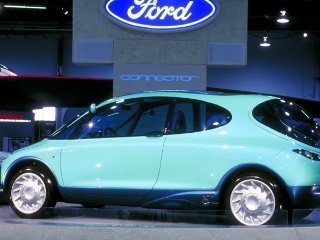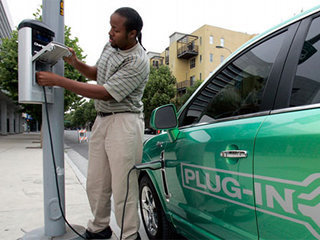
Looking to break into clean tech? Electric vehicles and EV infrastructure are the way to go. General Electric announced late Thursday that it will be buying 25,000 electric vehicles by 2015 in what many are saying is the largest order of electric vehicles ever.
Of those vehicles, 12,000 will come from General Motors, starting with the much-talked-about Chevy Volt in 2011, and will add more vehicles as manufacturers design and engineer them. The purchase is a strategic part of GE’s Ecomagination program to support the development of clean energy technology.
“With more than 16.3 million vehicles in operation in 2009, the nation’s fleet can drive initial ramp-up scale in the battery industry and OEM supply chains,” said Fred Smith, CEO of FedEx and Electrification Coalition member, in a prepared statement. “By buying these vehicles, GE is helping ramp up production which will help lower the price of vehicles and their components and make electric vehicles more visible and acceptable to the public at large.”
Additionally, GE boasts a portfolio of electric vehicle product solutions to support the EV infrastructure necessary for large-scale adoption. Product solutions include charging stations, circuit protection equipment, and transformers. GE anticipates that the electric vehicle market (including markets for GE’s charging station, WattStation) will generate approximately $500 million in revenue for the company over the next three years.
GE is also announcing the opening of two new electric vehicle customer experience and learning centers, which will provide customers, employees, and researchers with first-hand information about electric vehicles. One of the centers will be located in Van Buren Township, Michigan, outside of Detroit, as part of GE’s Advanced Manufacturing and Software Technology Center. The other will be located at GE Capital’s Fleet Services business headquarters in Eden Prairie, Minnesota. The centers, more of which will be announced in 2011, will monitor electric vehicle performance and charging behavior, driver experience, service requirements, and more, while also creating an opportunity to compare and contrast different makes and models.
GE’s announcement comes two weeks after Ford announced that it would be investing $840 million in fuel efficient cars between 2011 and 2013. A number of electric vehicle and EV infrastructure startups have been raking in funds as well, including Wrightspeed, a high-performance electric vehicle designer, which raised $5 million last week. In September, Coulomb Technologies, a maker of electric vehicle charging stations, raised $15 million in a Series C round.
“Electric vehicle technology is real and ready for deployment and we are embracing the transformation with partners like GM and our fleet customers,” said GE Chairman and CEO Jeff Immelt in the company’s announcement. “By electrifying our own fleet, we will accelerate the adoption curve, drive scale, and move electric vehicles from anticipation to action.”
Image source: crunchgear.com


















